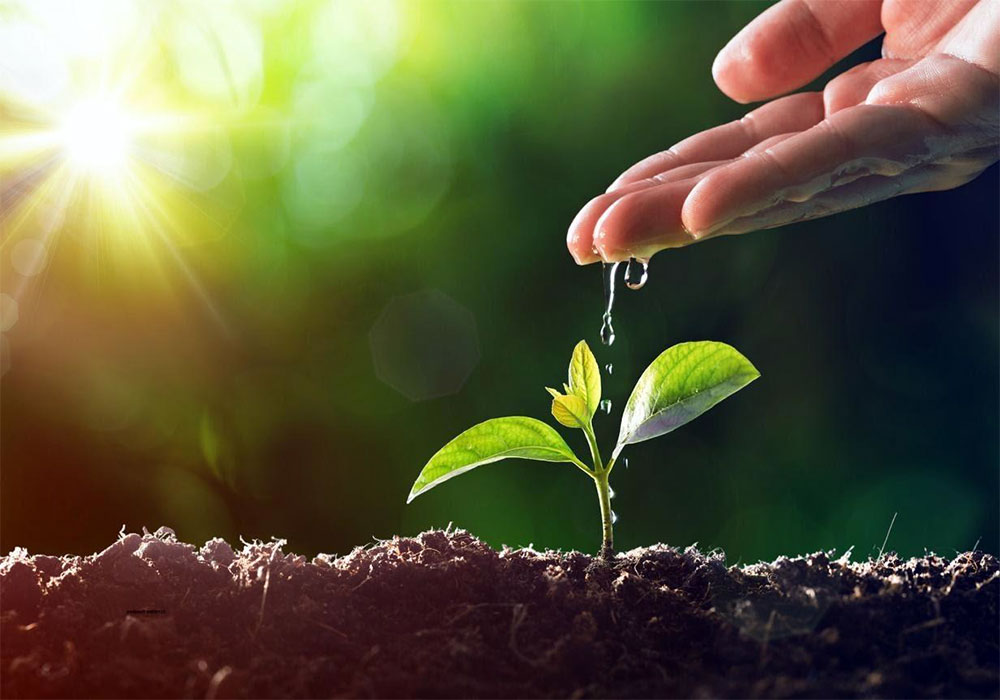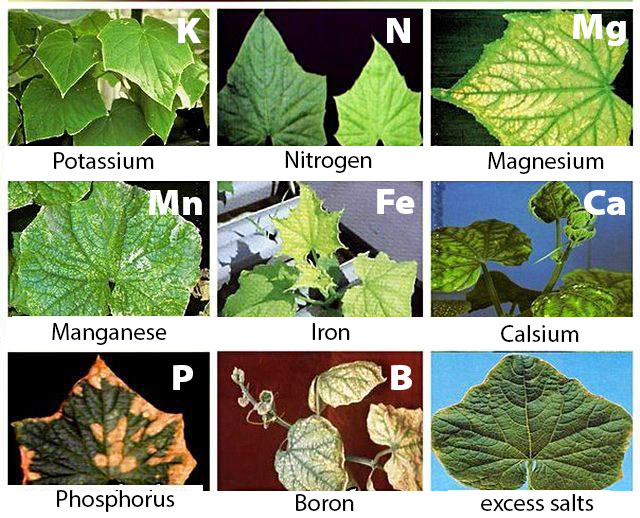Secrets of Happy Plants
Role of essential nutrinets in plant life
By Fedor Shabliy and Tatiana Berezhnaya

What are the secrets of the Green Thumb?
What do plants need for happy growth, really?
The answer is simple – water, sun, carbon dioxide, oxygen, and growing media. But what is it in the water, soil, and air for plants? Why do they need carbon dioxide? What do we need to provide for plants so that they grow vigorous, healthy and reward us with their beauty, or a good fruit? Let's explore this in more detail.
Plants, like any living organism, require adequate nutrition to grow. The concept of plant nutrition includes the following...

Carbon dioxide.
During photosynthesis, organic compounds are formed in leaves with chlorophyll pigment, water, carbon dioxide, and light, all of which play an important role in the life of a plant. They are responsible for plant biomass.
Photosynthesis is the main and only significant source of organic matter for plants.
Macro-nutrients.
Macro-nutrients include non-organic substances found in plants in significant amounts, such as Carbon, Oxygen, Hydrogen, Nitrogen, Phosphorus, Potassium, Sulfur, and Magnesium.
Micro-nutrients.
These are inorganic compounds involved in the synthesis of enzymes and biologically active substances of plants. Their content in a plant is very low, but they play a vital role in a plant's life. Micro-nutrients include: Silicon, Iron, Manganese, Zinc, Copper, Boron, Molybdenum, Cobalt.
Ultra-micro-nutrients.
They are found in even smaller amounts than micro-nutrients, but plants also need them for successful growth: Vanadium, Iodine, Nickel, Titanium, Aluminum, Cadmium, Fluorine.
Those who took a Science Class at school, may remember that “higher plants” are so called “autotrophic organisms”. This means, they are independently able to synthesize organic substances from inorganic substances with the help of light, water, and carbon dioxide. The accumulation of a plant's green mass (carbohydrates, proteins, amino-acids, lipids) occurs via absorption of carbon dioxide through leaves, while water and mineral elements are delivered from the soil through roots («root nutrition»).
In addition to nutrients, plant life is also affected by external factors such as:
- presence of carbon dioxide in the air;
- soil temperature around the roots and air temperature around the upper part of the plant;
- illumination of leaves;
- air humidity;
- quality of growing media
Temperature conditions in plant life
Temperature is one of the key factors for plant growth and development. It affects plant growth as much as the amount of light, carbon dioxide, air humidity, availability of water and nutrients. Every plant can exist and function normally only within a certain temperature range.
Temperature has an effect on:
- plant respiration;
- photosynthesis rate;
- growth rate and development;
- fruit setting and ripening;
- distribution of liquids and nutrients within a plant.
As you may know, based on the temperature range of their native habitat, plants can be divided into several categories: cold-tolerant, cold-sensitive, heat tolerant, etc.
For example, exposing thermophilic species (cold-sensitive, or tropical) to temperatures below 45-50F for a long period of time may cause various physiological abnormalities and disorders, followed by plant damage and even death (especially below freezing point which is critical to most cold-sensitive species and fatal to ultra-tropical species). But some cold damages can be reversible or recoverable if the temperature returns to normal before it's too late. This often happens in natural conditions.
For instance, at higher altitudes of the Tropics or Arid Subtopics, nights can be chilly, but they are followed by a hot day.
Temperate plants can survive pretty low temperatures, below freezing. But the optimal temperature range for their active growth and development is around 60-70F, this is when their metabolism is at its peak.
Some tropical and subtropical species won't tolerate high heat and prefer a slightly cooler environment, while their favorite, “thriving” temperature range is between 65-80F. These plants may take cooler temperatures for a short period of time; some may or may not survive a light freeze.
Examples: Onagraceae family (Fuchsias) Melastomaceae family (Tibouchinas).
Interestingly, certain plants require so-called “chill hours” during winter time in order to flower and/or produce fruit.
Examples of such subtropical fruit trees from Rosaceae family: Prunus sp (Peaches, Apricots, Nectarines), Malus sp (Apples, Pears). These plants can grow in frost-free climates but won't produce fruit without a certain amount of chill hours (200 or more).
Temperature also determines the accumulation of mobile nutrients in soil. It also affects the rate at which nutrients enter a plant from the soil and applied fertilizers. For example, below 45-50F, Nitrogen supply to roots and its movement from the roots to the rest of the plant are reduced. Below 40F root uptake of Nitrogen, Phosphorus and Potassium decreases dramatically.
In summary, proper temperature range, being a vital factor for successful growth and development of each species, is important to control and maintain.
Why do plants need light?

Have you ever noticed how houseplant leaves are directed towards the window? A plant is always trying to grow in direction where all these important supplies are available: light, soil, water, nutrients.
So why is light so important to plants? The answer is simple - for photosynthesis!
Photosynthesis is the main process of plant metabolism. Green parts of plants contain a substance called chlorophyll - plant green pigment. During photosynthesis, solar energy by means of this pigment transforms into chemical energy. This, in turn, is used to synthesize the “green matter” out of Carbon dioxide and water. During photosynthesis, plants assimilate Carbon dioxide that comes from the atmosphere through the leaves. Note that chlorophyll can be generated only with light!
Under the influence of sun rays, complex photo-chemical processes, that occur in leaves, give plants a chance to live, grow, bloom, and set fruit.
In other words, transformations of energy and minerals in plant metabolism change simple compounds into more complex compounds. Photosynthesis rate depends on the amount of light, carbon dioxide content in the air, and availability of water and mineral nutrition.
Once you understand this process in more detail, you will be able to learn exactly what you need to give your plants for successful growth.
So keep reading!
Light schedule is an important concept to understand. It includes three components:
- light level (amount of light)
- duration of daylight
- light spectrum
Sometimes houseplants are placed in spots without adequate lighting. In this case, adding an extra artificial light source will be helpful. As we already know, lack of light will slow down photosynthesis, leading to poor growth since very little organic matter is produced.
In order to grow plants successfully, it is also important to know the main characteristics of light:
- spectrum
- intensity
- daily and seasonal dynamics
Spectrum of the sunlight may vary based on conditions, because rays can have different wavelengths. Plant needs in particular light spectrums determine the selection of artificial light types. The table below summarizes light spectrum for different physiological functions of plants.
| Color | Wave length, nm | Impact on plants |
|---|---|---|
| Ultraviolet | < 380 | Harmful May cause leaf burn. Leaves turn yellow and twisted. |
| Violet | 380–430 | Promotes synthesis of vitamins. Responsible for trunk/stem thickness. Improves cold hardiness. Encourages more vigorous, stronger growth. |
| Blue | 430–490 | Promotes leaf development and increases their size, leading to increased photosynthesis and stimulating further growth. |
| Green | 490–570 | Not important in plant life, reflected by leaves. |
| Yellow-green | 570–600 | Responsible for plant height, important during germination and vegetative stage of plant development (up to pre-flowering stage). |
| Orange-red | 600–780 | Optimizes chlorophyll production. Promotes germination, growth, flowering, and fruit development. |
| Infrared | >780 |
Raises plant's temperature. Can be dangerous and cause damage or death. |
With excessive light, chlorophyll partially breaks down, and leaf color turns yellowish-green. At the same time, strong light retards growth rate, plants look stumpy and more compact, grow smaller size leaves: shorter and narrower. Bronze-yellowish leaf color indicates a significant excess of light that may be harmful to a plant and cause leaf burn unless conditions are modified.
Daily and seasonal dynamics of light are also important, based on individual species needs.
Soil, water, and humidity - the basics of a plant's life.

Selecting a wrong planting media, or soil substrate, entails a considerable risk and may cause serious problems in the growing process.
Most importantly, soil must meet a plant’s needs in obtaining elements of mineral nutrition, air, and moisture.
Along with carbon dioxide, light, and water, substrate is a vital element of environment and most plants can't live without it.
The main characteristics of the substrate for growing plants:
- Solid components necessary to hold the roots;
- water- and air permeability, drainage characteristics;
- soil acidity;
- ion exchange capacity, or ability to retain nutrients.
The right combination of these characteristics provides the proper conditions for a plant.
Cultivated plants, vs those growing in the wild, are lucky to be able to get additional food offered them by a grower. Balanced plant nutrition creates perfect conditions for healthy, happy plants.

One should remember that all nutrients can be available to a plant only in water-soluble form, as water is the basics of life on Earth. Any physiological process can occur only with the presence of water. Besides, due to its high heat capacity, water also contributes to the relative stabilization of plant temperature.
The main source of water for plants is moisture contained in the soil. The process of water absorption, as well as root growth, is greatly affected by soil acidity, or the pH of the nutrient solution. In general, a slightly acid or neutral soil is most suitable for plants. Some plants, including tropical species, prefer acidic soils (examples: Azaleas, Roses, many Rain Forest species).
Most plants, especially tropical, enjoy high air humidity of 60-70%, although they can survive and even stay healthy at lower ranges. Arid (desert) species can live at air humidity as low as 20-30% and below, while higher numbers may create health issues for them.
Air humidity determines the rate at which the plant receives and evaporates water. When air is dry, this rate can be three times higher than in humid air. At 60-65% relative humidity, most indoor plants can be grown successfully. If the air is too dry, you may notice dry edges on leaves or even leaf/flower/bud drop. In this case, air humidifiers can help, or simply placing pots on a tray with pebbles and some water may benefit.
For many plants, especially for tropicals, roots are not the only mechanism for water absorption; leaves also deliver a great deal of moisture.
It is important to realize that you can not compensate low air humidity with extra watering!
Excessive watering can be as harmful as a lack of it.
First, excessive water in the soil creates a “soggy” environment with a lack of aeration and oxygen which may lead to root rot.
Second, wet soil means cooler soil, and at lower temperatures reduces nutrient absorption rates.
Drought is also no good. It disrupts the plant’s nutrition mechanism by reducing solubility of salts. When water is scarce, plants start growing deep, un-branched roots which reduce nutrient input. As a result, the absorbing part of the root system (including so-called “little root hairs” that play a dramatic role in supplying a plant with necessary elements) decreases. The tap root is deep (way below the fertile layer of the soil) where there are fewer nutrients available. Besides, within deeper layers of soil, the lack of oxygen may also be ugly for plant metabolism. In addition, extra Carbon Dioxide accumulating in deep soil can be toxic in large quantities, and excess compounds of iron and manganese build while absorption of nitrogen, phosphorus and other elements is depressed.
It is important to know that roots don't absorb the complete soil solution, but rather selectively take ions of necessary elements dissolved in that liquid. As a result, Potassium and Phosphorus, for example, can be absorbed faster than water itself, while delivery of Calcium, Magnesium and Sulfur may be delayed.
After considering all the factors affecting plant growth and development, in order to have a happy, healthy, flowering/fruiting plant, all we have to do is to provide it with -
a) all necessary balanced nutrients
b) optimal growing conditions.
What mineral nutrients do plants need?

In addition to sunlight, carbon dioxide, water, oxygen, a happy plant requires basic elements of mineral nutrition. Those elements fall into three categories: macro-nutrients, micro-nutrients, and ultra-micro-nutrients.
Macro-nutrients
Macro-nutrients are inorganic substances that are essential to plants in large quantities. These elements present in stems and fruits of a plant. They are important for the main processes - creating green mass, respiration, maintaining plant's metabolism.
These elements include: Carbon (C), Oxygen (O), Hydrogen (H), Nitrogen (N), Phosphorus (P), Potassium (K), Calcium (Ca), Sulfur (S), Magnesium (Mg), Sodium (Na), Chlorine (Cl).
Micro-nutrients
The content of micro-nutrients in a plant is much lower than that of macro-nutrients, but they also play a vital role in plant metabolism. These nutrients are part of enzymes that work as catalysts of biochemical processes.
Lack of micro-nutrients can be the reason for decreased rate of plant development and yield failure. It causes a number of plant diseases, and can even leads to plant death. The main plant micro-nutrients are Silicon (Si), Iron (Fe), Manganese (Mn), Zinc (Zn), Copper (Cu), Boron (B), Molybdenum (Mo), Nickel (Ni), Cobalt (Co).
Ultra-micro-nutrients
Ultra-micro-nutrients are found in plants in even smaller amounts than micro-nutrients. Their roles in plant metabolism remains partially unclear. Strontium (Sr), Vanadium (V), Iodine (I), Titanium (Ti), Aluminum (Al), Cadmium (Cd), Bromine (Br), Fluorine (F) are considered more or less necessary.
The main natural route for all of the above nutrients to enter the plant is through the root system. The root system of a plant consists of a number of main roots and huge number of tiny roots, invisible without a magnifying glass or a microscope. They are so-called “root hairs”, virtually as thin as a hair, hence the name.
The count of root hairs of an adult plant can be tens of millions. Thanks to this advanced root system, a plant absorbs water and dissolved nutrients from the soil, providing the plant with necessary macro- and micro-nutrients.
As a proven fact, a plant leaf can also absorb nutrients from solutions, sometimes even more efficiently than through the root system. This method of fertilizing through the leaves is called foliar feeding.
Now, let’s look at the functions of the basic nutrients, so we can understand what and how much we need to give to a plant? Check out the table below.
Macro Nutrients
| Element | Function | Deficiency symptoms |
|---|---|---|
| N Nitrogen |
- necessary for formation of amino acids, the building blocks of proteins; - directly involved in photosynthesis; - essential component of vitamins; - participates in synthesis and use of carbohydrates; - affects energy reactions in the plant; - important for color differentiation; - promotes growth of new shoots; - synthesis of ATP; - acts as a catalyst for other nutrients. |
- insufficient growth or stunted growth; - yellowing of leaves; - loss of leaves at a serious deficit; - purple coloration due to the accumulation of the corresponding pigments; - dark-yellow color appears beginning from the middle of leaf rib to the plant. |
| P Phosphorus |
- helps to improve cold resistance; - accelerates development and maturation; - stimulates fruit production; - improves drought resistance of the root system. |
- reduced rate of oxygen absorption; - decreased activity of respiratory enzymes; - delayed protein synthesis; - bluish-green, purplish coloration appears, primarily on older leaves; - leaves become smaller and narrower; - suspended growth; - delayed crop |
| К Potassium |
- necessary for cell division, cell electrolyte balance, and stomata functioning; - affects cold, drought- and disease resistance |
- leaves turn yellow from the bottom up, from old to young; - leaf edges and the tops become chipped, sometimes with red spots, then leaves dry from edges or twist and wrinkle; functioning of cambium (conductive layer) is reduced, vascular tissue development is impaired, cell wall thickness is reduced, cell division and stretching processes are inhibited, leading to appearance of “rosette forms”; - slows down sucrose transportation, development stops, dying of apical buds, thus growth of lateral shoots is activated and the plant takes a form of a bush. |
| Ca Calcium |
- affects the metabolism of carbohydrates and proteins; - provides favorable conditions for root system development |
- leaf whitening followed by blackening of tips and edges; - leaves curve and twist upward; - dead spots on fruit - mostly on top of the fruit. |
| Mg Magnesium |
- key element in chlorophyll production; - necessary for setting seeds; - activator and component of many plant enzymes; - improves phosphorus absorption and mobility - helps regulate absorption of other plant products; - increases use of iron; - promotes formation of oils and fats; - affects prematurity and uniformity of fruit ripening. |
- general loss of green color, starting with the lower older leaves, which progresses upwards; - spots and stripes of light green and then yellow between green veins; - leaves curl upwards at the edges; - weak stems and long roots; - leaf edges turn yellow, orange, red or dark red. Signs at first appear on old leaves, and then spread to young leaves. |
| S Sulfur |
- Essential part of the amino acids necessary for protein formation; - helps to produce enzymes and vitamins; - necessary for chlorophyll formation; - helps to maintain dark green color of plants; - promotes formation of tubers of leguminous cultures; - stimulates seed production; - activates plant growth. |
- inhibited synthesis of sulfur-containing amino acids and proteins; - reduced rate of photosynthesis growth; - chlorophyll destruction; - stems turn yellow and leaves bright yellow, with even lighter veins; - plants become stunted, with short, thin stems. |
Micro Nutrients
| Element | Function | Deficiency symptoms |
|---|---|---|
| Cl Chlorine |
- positive effect on tissue elasticity and cell swelling; - activates enzymes responsible for photosynthesis; - participates in energy metabolism; - helps plants recover from fungal infections. |
- leaf chlorosis; - reduction of the root system; - yellowish, spotted leaves; - wilted leaves |
| Na Sodium |
- activates a number of enzymes; - participates in transportation through cell membranes; - regulates carbohydrate delivery; - improves cold hardiness. |
- reduced chlorophyll formation; - signs of chlorosis and necrosis in leaves; - delayed flower development. |
Fe |
- necessary for chlorophyll synthesis; - acts as an oxygen carrier; - takes part in the mechanism of cell division and growth. |
- retarded plant growth; |
| Mn Manganese |
- participates in chlorophyll synthesis; - participates in photosynthesis; - promotes processes of oxidation and respiration; - speeds up seed germination and fruit ripening, resulting in quality crop; - increases availability of calcium, magnesium, and phosphorus; - works as a part of certain enzyme systems. |
- leaf spot chlorosis, when yellow spots appear between the veins and then the cells in these areas die off; Manganese deficiency is exacerbated by low temperatures and high humidity. |
| Zn Zinc |
- promotes growth hormones and enzyme system; - necessary for chlorophyll synthesis; - necessary for the formation of carbohydrates; - necessary for seed germination. |
- white area between veins (chlorosis); |
| B Boron |
- promotes calcium and potassium absorption, especially for crops that use high levels of potassium; - improves nutrient uptake and carbohydrate transport from leaves to roots and reproductive organs; - necessary for seed and cell wall formation; - promotes pollination and fruit ripening. |
- synthesis, conversion and transport of carbohydrates, formation of reproductive organs, fertilization and fruiting are disrupted; - bad pollination; - leaf blades thicken, curl, become brittle. |
| Cu Copper | - important for inter-cellular metabolism and acts as an oxidizer in chemical reactions; - takes part in photosynthesis and chlorophyll production; - increases carbohydrate content. - brightens colors; - improves taste of fruit and vegetables. |
- few or no fruit; - S-shaped tips with large leaves; - delayed growth and blooming; - chlorosis, loss of cell elasticity; - undeveloped ear in grains; - tips of leaves turn white and die off; - brown spots. on leaves and fruit |
| Mo Molybdenum |
- required for production of a number of enzymes; - promotes formation of tubers of leguminous cultures; - necessary for the conversion of inorganic phosphates into organic forms. |
- general yellowing of old leaves (lower part of the plant);
- young leaves turn gray on the edges and then brown, lose the turgor (pressure within the cells) and then the leaf tissue dies. |
| Co Cobalt |
- participates in the synthesis of proteins, nucleic and fatty acids, carbohydrates; - affects the accumulation of nitrogenous substances, accelerating their outflow from vegetative to generative organs; - increases respiration and photosynthesis, promoting formation of chlorophyll, reducing its breakdown in the dark; - participates in enzyme systems of nodule bacteria that perform atmospheric nitrogen fixation; - stimulates growth, development and productivity; - increases the total water content of cells. |
Signs of cobalt deficiency are similar to those of nitrogen deficiency: The most noticeable deficiency of this micronutrient is in bean cultures. |
On the photo below you can see examples of various element deficiencies.

And as we can see from the photo, the lack of mineral nutrition can lead to some serious plant damage.
Keep in mind that light plays a tremendous role in plant metabolism and element absorption of micro- and macro-nutrients. For example, Potassium and Phosphorus are absorbed faster in bright light. Sulfur, nitrogen and magnesium are better absorbed in the dark, etc.
Note that all macro-nutrients and micro-nutrients are interacting and affecting absorption of each other. For example, an overdose of Phosphorus can lead to a lack of Zinc and formation of Iron and Copper phosphates. As a result, these metals become unavailable for plant uptake. Molybdenum uptake decreases with an excess of Sulfur. An excess of Manganese caused by Iron deficiency can lead to chlorosis. In its turn, Iron deficiency leads to high concentrations of Copper. With Boron deficiency, Calcium absorption is impaired, etc.
This is why it is so important to use balanced formulas of fertilizer nutrient solutions and fix mineral deficiencies.
When creating the most efficient plant feed system, it is important to take into consideration an unequal need and intensity of absorption of individual nutrients. It is of vital importance to provide favorable conditions from the beginning of the grow season and during periods of active growth. This can be done by using scientifically balanced fertilizers with a custom nutrition profile for each crop.
So what should you give to YOUR plants?
Talk to us and get your questions answered!
See also: Understanding essential nutrients
Photos of element deficiencies

Examples of micro-element deficiencies:























